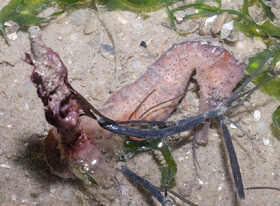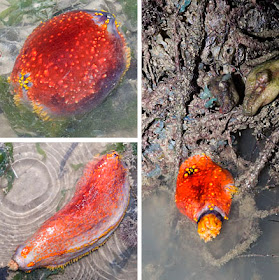We also saw lots of Sea apple sea cucumbers and other amazing marine life.
The rest of the team also saw some seahorses including a tiny one. It's good to know that the Estuarine seahorse (Hippocampus kuda) is still on Changi. Other interesting fishes seen were many slender Seagrass pipefishes, and a pretty colourful Diamond wrasse (Halichoeres dussumieri).
We are also astonished to see so many Sea apple sea cucumber (Pseudocolochirus violaceus) today. I saw four in a small area on the shore. On my last trip here in April, I did see two Sea apple sea cucumbers but no seahorses.
Indeed, this stretch of Changi is thickly populated with all kinds of echinoderms. Lots of Biscuit stars (Goniodiscaster scaber) from tiny ones to medium sized ones. Plenty of Thorny sea cucumbers (Colochirus quadrangularis) and Warty pink sea cucumbers (Cercodemas anceps). In the soft silty sand there were many buried Ball sea cucumbers (Phyllophorus sp.) and many Cerianthids (Order Ceriantharia) with Phoronid worms. And squirming around were many flat-armed brittle stars.
In fact, we saw many different kinds of sea cucumbers today. Among those yet to be identified is this plain and beige animal. It has black feeding tentacles.
Another one that is beige but has regular dark spots along the sides. It is also longer and has white feeding tentacles. So it looks like there are two different kinds of beige sea cucumbers?
This strange one with orange tipped tube feet that I keep seeing here, usually buried in the ground. Hopefully, the experts can help us sort out their identity!
It was also heartening to see many Seagrass octopuses on this shore. I've seen fishermen collect these harmless beasts to use as bait. I'm glad this practice has not wiped them out.
A very common snail on our shores, the Common whelk (Nassarius livescens) has a very long foot that it uses to 'hop' around quickly when it needs to. The little round patch on the foot is the 'door' or operculum that is used to seal the shell opening when the snail retracts into its shell. There were many Calf moon snails (Natica vitellus) out and about. And the rest of the team saw several Miliaris cowries (Cypraea miliaris).The only slug I saw today was a single Geographic sea hares (Syphonota geographica).
I'm looking out for special anemones and came across this pretty Polka dot anemone. It has yet to be identified. So far, we've only seen these at Changi and Cyrene Reef.
I saw this Haddon's carpet anemones (Stichodactyla haddoni) in the process of eating a large crab! The Tiger anemones were still common here too.
Large parts of the shore was blanketed in a thick carpet of Nest mussels (Musculista senhousia). I took a closer look to see what animals are found on this mat. These include Slender sea pens (Virgularia sp.), cerianthids, Fan clam (Family Pinnidae), sand stars (Astropecten sp.) and even a mangrove seedling that had taken root in the mat.
Among the scariest creatures (for the Nest mussels) must be this fast-moving Silt flatworm that looks like mobile phlegm. Being very flat, it can squirm among the mussels and squeeze through the tiniest gap in the shells to eat them!
I saw several patches of these seagrasses with elongated leaves growing well embedded in the mat of Nest mussels. Could these be the Hairy spoon seagrass (Halophila decipiens)? I saw these yesterday too at another stretch of Changi, and we have seeing these at Changi and at Punggol. Hope we can sort this out eventually.The meadows are dominated by Spoon seagrass (Halophila ovalis), but there were also some Fern seagrass (Halophila spinulosa). The seagrasses looked good today.
There was a small patch of sea fans (Order Gorgonacea) and I saw one Ball flowery soft coral (Family Nephtheidae). As well as many sponges growing on hard surfaces.
There were many Spiky sea pens (Scytalium sp.) on the shore and I took a closer look at one that was still submerged to see how the polyps in the colony were arranged. Oh, they emerge perpendicular to the 'leaves' thus forming a net of tiny tentacles to trap food.
Also abundant on the shore were Black sea urchins (Temnopleurus sp.), gathered together in numbers. I notice some of them look slightly different.
After a quick look at this stretch of Changi, we hurried over to join Prof Peter Ng and the team from the Raffles Museum of Biodiversity Research who are working on another stretch of Changi. They have found lots of interesting things too including another Numbfish (Narcine sp.)!
As usual, we learnt a lot from Prof Peter, from identification of sea creatures, how they got their names and how to operate the 'Yabby Pump". I also managed to find lots of chitons (Class Polyplacophora) here! These animals are molluscs with a flexible armour.
There's so much more to discover and learn about our shores, and too few super low spring tides! Not to mention not enough hours in the day to get some much needed sleep.
Tomorrow, another early start, this time to check up on Labrador for TeamSeagrass monitoring.
Posts by others on this trip
- Kok Sheng with lots of awesome photos of the Sea apple, special sea stars and more!
- Mei Lin with colourful sea cucumbers, snails and seahorses, and a hornbill family spotted in the park nearby.



















